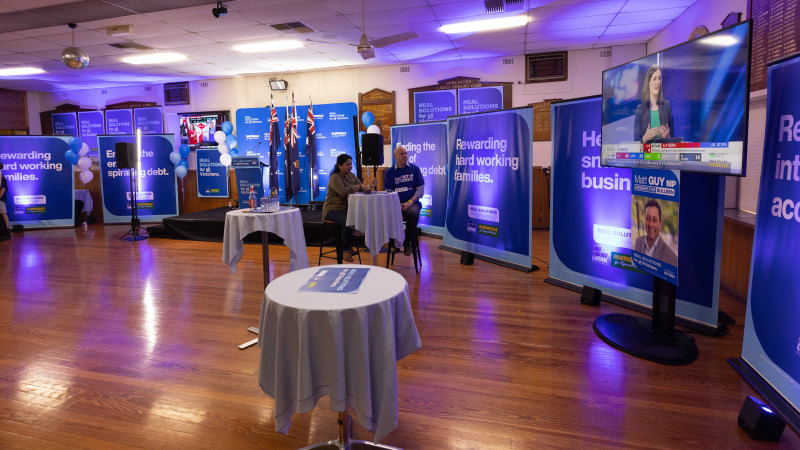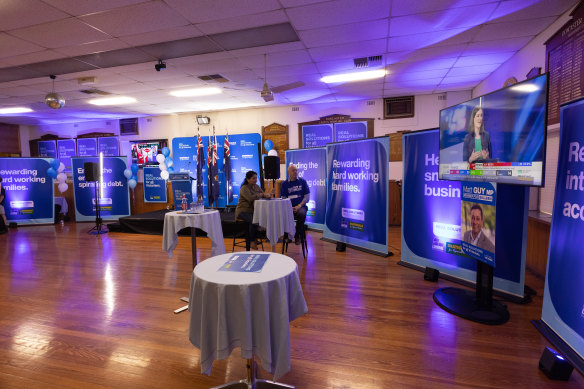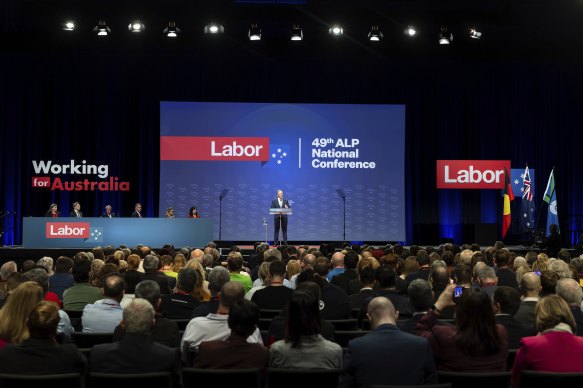Save articles for later
Add articles to your saved list and come back to them any time.
Eavesdropping on a few conversations in Melbourne’s CBD this week while waiting for a long black, you won’t be surprised to hear that most conversations revolved around the Matildas’ chance of winning the Women’s World Cup.
Soccer aside, city workers were also whinging about their commute, the rising cost of living and engaging in Australia’s favourite pastime – obsessing about the housing market.
The near-empty Liberal Party election night gathering at the Doncaster Bowls Club.Credit: Jason South
What struck me as I returned from this coffee run to harass politicians on the phone, was how far removed MPs were from the issues on the street. Liberal and Labor may be split on policy debates, but they appear to be in lockstep when it comes to their current woes.
Over in Labor land, MPs and party people are obsessing about a factional fight to appoint a new state secretary to lead the Victorian ALP following the resignation of Chris Ford. The tussle over Ford’s replacement is the latest proxy battle in the factional war for control of the state branch.
In light of the revelations that two dead men had their signatures forged by the ALP branch associated with Andrews government minister Lily D’Ambrosio, there was also an intense focus on finding the culprit.
And by culprit, I mean the person responsible for the internal “hit” on one of Daniel Andrews’ closest allies, not uncovering who was responsible for recruiting the dead.
Liberal types are dedicating just as much energy to finding a potential challenger to Victorian Liberal Party president Greg Mirabella, driven by an imbedded factional divide and some naive belief that one man is somehow responsible for an entire state party’s woes.
Their solution isn’t to breathe fresh ideas into the party with a new recruit, but instead to resurrect a retired MP or senator – a move that will potentially destabilise the already unsettled parliamentary team.
While constituents stress about falling off a “mortgage cliff” as their fixed home loan rates expire, Victorian MPs are obsessively preoccupied with solving the mystery as to which federal seat will be abolished in the next redistribution. Important, sure, but it’s not quite the same insecurity keeping voters awake at night.
While this navel-gazing is nothing new, it does go some way to explaining why registration numbers to major political parties are declining and why like-minded voters are refusing to sign up.
It’s not just the disconnect between the priorities of politicians and the concerns of citizens that’s caused parties to have fewer members than most AFL clubs. Their rigid structures and analog system are also acting as a barrier to a new generation of supporters.
Back in June, former ALP assistant state secretary Kos Samaras used the party’s state conference to encourage Victorian Labor to shift some of its meetings and systems online to build its membership base.
His suggestion was in response to a push within Labor to set up more branches in an era when most peoples’ political interactions are online and few people have the time or energy to attend in-person branch meetings.
The Liberal Party faces a similar problem, where branch meetings are often poorly attended, dominated by one generation, and time is sucked up dealing with petty personal animosities and feuds.
Prime Minister Anthony Albanese during the Australian Labor Party National Conference in Brisbane.Credit: Alex Ellinghausen
Parties know that increasingly, young people – who they will need to recruit if they want to remain relevant – are drawn to issues, not broad political ideologies. Increasingly, they see joining a major political party as buying into the problem.
Armed with this knowledge, you’d think Labor and the Liberals would set about making their organisations more democratic, open and issues-based. But instead, members who question policy positions or challenge ideas are increasingly deemed disloyal to the team.
Take Labor’s national conference in Brisbane this week, where members were forced to fill out an expression of interest form before being allowed to debate policies on the conference floor.
This rigid mindset is proving unappealing to a generation of Millennials and Zoomers, who have grown up in a world where they have been encouraged to share their opinions freely thanks to social media. They don’t need to sign up to a party, pay membership fees and attend branch meetings to be part of a political debate.
Much is made about the demographic timebomb facing the Liberal Party. Their older members will eventually die off, and the party will struggle to attract those in Gens Y and Z, who are shown to be sticking with their progressive views as they age.
But Labor’s rigid structures and reluctance to give its members a direct say in important party decisions is also alienating this generation it should naturally attract.
Officials from both the Labor and Liberal parties can see the problem, but seem unable to make their organisations more appealing and open to like-minded thinkers who are turned off by the pomp and structure of the past.
While political parties from both sides of the spectrum have always attracted extremists, weirdos and wannabe careerists, dwindling memberships are proving to be an existential threat to these organisations and could make them even less representative of the wider population.
It’s a cycle of self sabotage that’s putting political parties in danger of dying.
Annika Smethurst is state political editor.
The Opinion newsletter is a weekly wrap of views that will challenge, champion and inform your own. Sign up here.
Most Viewed in Politics
From our partners
Source: Read Full Article


